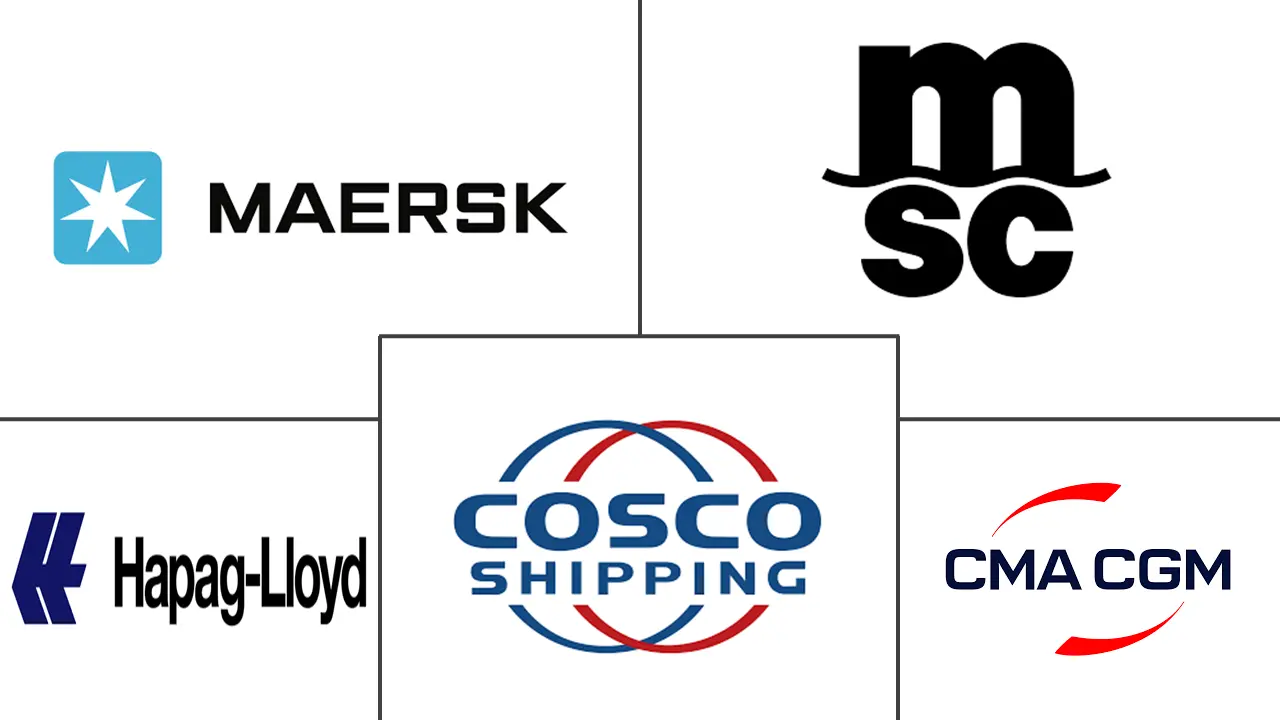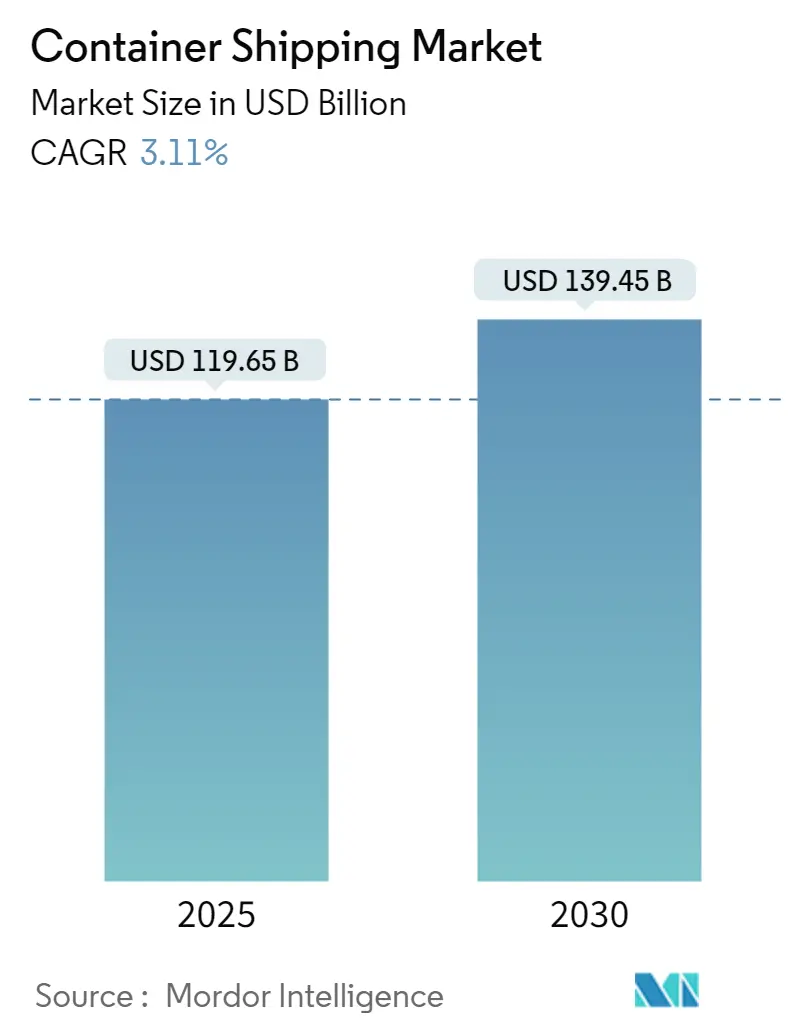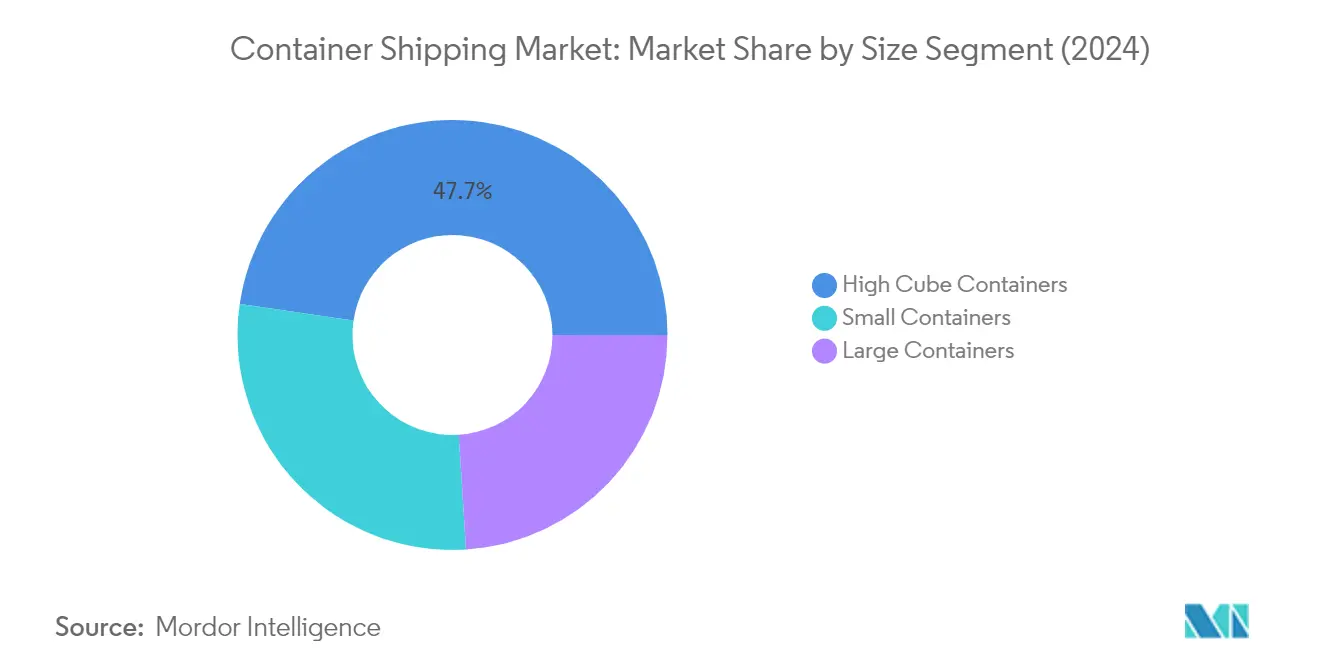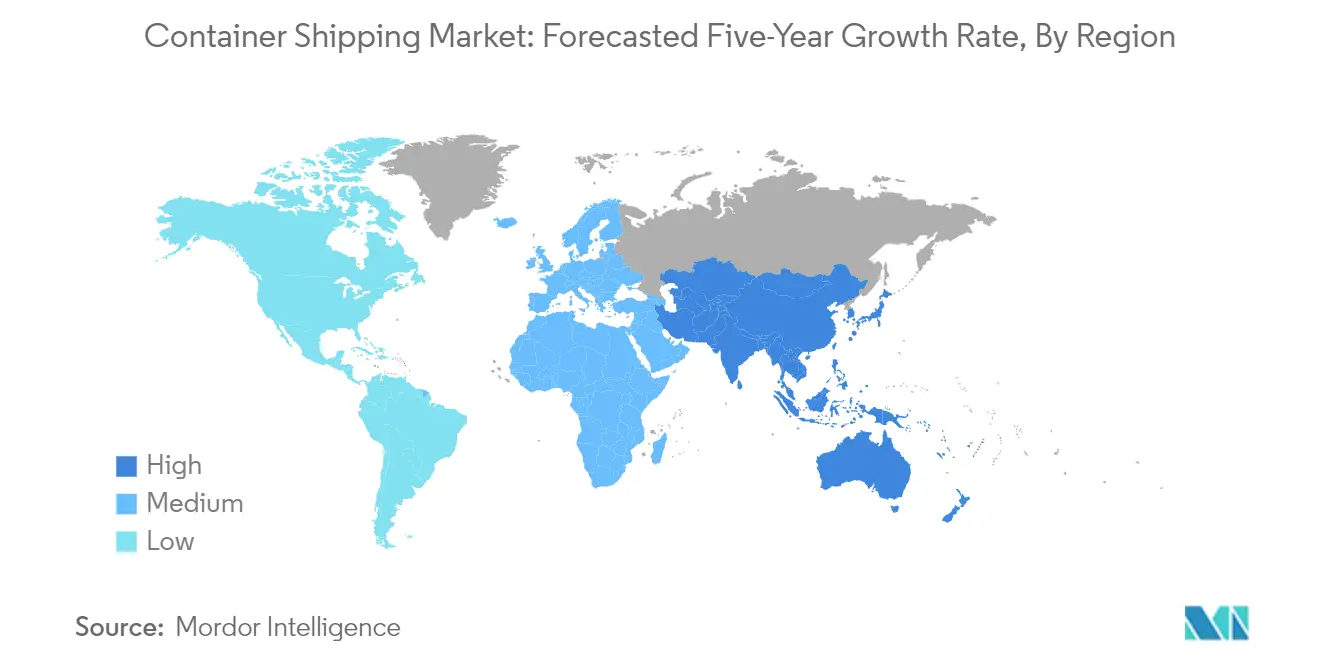Container Shipping Market Analysis
The Container Shipping Market size is estimated at USD 119.65 billion in 2025, and is expected to reach USD 139.45 billion by 2030, at a CAGR of 3.11% during the forecast period (2025-2030).
The global container shipping industry is experiencing significant transformation driven by technological advancement and digital innovation. Recent industry surveys indicate that technology and planning investments are leading the trend, with 30% of companies prioritizing these areas, while 27% focus on improving collaboration and connectivity, and 24% emphasize real-time visibility and tracking capabilities. This digital transformation is reshaping traditional shipping operations, with process automation gaining traction among 18% of industry participants, highlighting the sector's commitment to modernization and efficiency improvements.
The industry is witnessing a paradigm shift towards sustainability and environmental compliance, particularly with the implementation of new regulations in 2024. The European Union's Carbon Border Adjustment Mechanism (CBAM) now requires all EU importers to report carbon emissions related to specific products, while the expansion of the Emission Trading System (ETS) to include maritime shipping has prompted carriers to adopt more sustainable practices. Major shipping companies are responding by implementing slow steaming practices, introducing biofuels such as ammonia and methanol, and exploring innovative solutions to meet these stringent environmental requirements.
Supply chain resilience has become a critical focus area, with companies actively diversifying their routes and implementing robust risk management strategies. The ongoing situation in the Red Sea has prompted shipping companies to strategically rethink their trade routes, leading to increased adoption of alternative pathways and the development of more flexible logistics networks. This adaptation has resulted in shipping companies investing in enhanced tracking capabilities and real-time monitoring systems to ensure cargo security and operational efficiency.
The container shipping industry is experiencing substantial growth in fleet modernization and capacity enhancement initiatives. For instance, Hapag-Lloyd has significantly expanded its reefer container fleet from 93,000 to 149,000 units, demonstrating the industry's commitment to meeting evolving market demands. Similarly, Singapore's remarkable achievement of handling 39 million TEUs in 2023 underscores the industry's capacity for growth and adaptation to increasing trade volumes. These developments are accompanied by substantial investments in port infrastructure and handling capabilities, with major ports worldwide upgrading their facilities to accommodate larger vessels and handle higher volumes efficiently.
Container Shipping Market Trends
Increasing Volume of International Trade
The global container trade is primarily driven by the steady increase in international trade volumes, particularly evident in recent developments through 2023. After several quarters of decline, G20 merchandise trade growth flattened in value terms in Q4 2023, as measured in current USD, with a robust recovery in East Asia counterbalancing slowdowns in Europe and North America. China recorded a 0.6% increase in exports, driven by high-tech products such as mobile phones, and a 3.9% increase in imports due to mechanical and electrical products. This was complemented by significant export growth in Japan and Korea, primarily due to strong automobile sales and a recovery in the Korean semiconductor business.
The trade landscape has shown remarkable resilience and adaptation, with higher sales of primary commodities fueling export growth in Australia, Indonesia, and Brazil. While the recent decline in global container trade has been more marked for developing countries, with imports and exports declining by an average of 6% and 7%, respectively, the North American region has demonstrated better performance, particularly in intra-regional trade. East Asian trade exhibited notable weakness throughout 2023 but showed signs of recovery in Q3 2023, indicating a gradual stabilization of trade flows. The transformation of trade patterns is further evidenced by the strong decline in exports from the Russian Federation, Central Asia, and the African region, particularly on an annual basis.
Expansion of Emerging Markets
The expansion of emerging markets continues to be a significant driver for the container shipping market, with developing economies showing increased participation in global trade networks. International trade plays a crucial role in promoting economic development, with many countries benefiting from enhanced access to resources and markets. This is particularly evident in the case of nations with limited natural resources, which can now import raw materials from other countries to boost their businesses and exports. Government initiatives, such as India's Production Linked Incentive Scheme, have been instrumental in boosting export capabilities and attracting foreign investment.
The growth of emerging markets is further supported by increased foreign investment and infrastructure development. For instance, India's major ports demonstrated significant improvement in handling capacity, processing 463.98 million tons of cargo traffic between April and October 2023, showcasing the impact of infrastructure enhancement and modernization efforts. China's export sector also showed remarkable resilience, with a 14.8% increase in March 2023 compared to the previous year, highlighting the growing importance of emerging economies in global trade. This expansion is further evidenced by the container industry's evolution, where production volumes shifted from 6.6 million dry freight containers to an expected 3.45 million TEU, indicating a market adjustment to changing trade patterns and efficiency requirements in emerging markets.
Segment Analysis: By Size
High Cube Containers Segment in Container Shipping Market
High cube containers have emerged as the dominant force in the global container market, commanding approximately 48% market share in 2024, with a market value of USD 55.34 billion. These containers, which offer an additional foot of height compared to standard containers, have become increasingly popular due to their enhanced cargo capacity and versatility in handling various types of cargo. The segment's dominance is particularly evident in the transportation of lightweight, voluminous cargo and overheight cargo up to 2.70 meters tall. High cube containers are extensively utilized across major shipping routes, especially in trade lanes connecting Asia with Europe and North America, where maximizing cargo volume per container is crucial for operational efficiency. The segment's growth is further supported by the expanding e-commerce sector and the increasing demand for consumer goods transportation, where the extra vertical space proves invaluable for optimizing shipping costs.
Remaining Segments in Container Shipping Market Size Segmentation
The shipping container market's remaining segments, namely small containers and large containers, play crucial complementary roles in the global shipping industry. Small containers, including 20-foot units, are particularly vital for heavy cargo transportation such as minerals, metals, and machinery, where weight restrictions often prevent full utilization of larger containers' volume. These containers are especially popular in ports with space constraints and for shorter shipping routes. Large containers, primarily comprising standard 40-foot units, serve as the backbone for general cargo transportation, offering a balance between capacity and maneuverability. They are particularly well-suited for lighter cargo types such as textiles, electronics, and consumer goods, where volume rather than weight is the limiting factor. Both segments continue to serve specific niches in the market, with their usage patterns largely determined by cargo type, trade routes, and port infrastructure capabilities.
Segment Analysis: By Type
General Container Shipping Segment in Container Shipping Market
General Container Shipping continues to dominate the global containerized shipping market, holding approximately 92% market share in 2024, valued at USD 106.55 billion. This segment's commanding position is driven by the extensive movement of non-refrigerated cargo, including consumer goods, electronics, textiles, machinery, and industrial products across global trade routes. The segment has shown remarkable resilience despite global economic challenges, with major shipping lines expanding their general container fleets and implementing technological advancements to improve operational efficiency. The growth in e-commerce, manufacturing sector expansion, and increasing international trade agreements have further strengthened this segment's market position. Additionally, the development of smart ports and digital transformation initiatives in major shipping hubs has enhanced the handling capacity and efficiency of general container operations.
Reefer Container Shipping Segment in Container Shipping Market
The Reefer Container Shipping segment is emerging as the fastest-growing segment in the container freight market, projected to grow at approximately 5% CAGR from 2024 to 2029. This accelerated growth is primarily driven by the increasing global demand for temperature-sensitive goods, particularly perishable foods, pharmaceuticals, and specialty chemicals. The expansion of cold chain logistics networks, stringent regulations for temperature-controlled transportation, and growing international trade in fresh produce and pharmaceutical products are key factors propelling this segment's growth. Technological advancements in reefer container monitoring systems, including real-time temperature tracking and smart container solutions, have enhanced the reliability and efficiency of refrigerated shipping services. Major shipping lines are increasingly investing in modern reefer container fleets equipped with advanced cooling technologies and environmentally friendly refrigeration systems to meet the evolving market demands.
Container Shipping Market Geography Segment Analysis
Container Shipping Market in North America
The North American container shipping market encompasses a robust network of ports and shipping routes across the United States, Canada, and Mexico. The region benefits from extensive coastlines on both the Pacific and Atlantic Oceans, enabling efficient maritime trade with Asia and Europe. The United States dominates the regional landscape with major ports like the Los Angeles/Long Beach complex, while Canada's infrastructure development and Mexico's strategic location contribute significantly to the regional market dynamics. The region has shown remarkable resilience in adapting to global supply chain disruptions and implementing technological advancements in port operations.
Container Shipping Market in United States
The United States maintains its position as the largest container shipping market in North America, commanding approximately 28% of the regional market share in 2024. The country's dominance is supported by its extensive network of ports, with the Port of Los Angeles/Long Beach serving as a crucial gateway for trans-Pacific trade. The U.S. market has demonstrated significant developments in port infrastructure modernization and automation. Recent initiatives focus on reducing port congestion, improving supply chain efficiency, and enhancing digital integration across maritime operations. The country's strategic focus on strengthening its maritime capabilities and implementing advanced technologies continues to reinforce its position as a key player in global container shipping.
Container Shipping Market in Mexico
Mexico emerges as the fastest-growing container shipping market in North America, with a projected growth rate of approximately 4% during 2024-2029. The country's strategic location, bordering both the Pacific Ocean and the Gulf of Mexico, provides significant advantages for maritime trade. Mexico's ports have undergone substantial modernization efforts, particularly in handling increased cargo volumes and improving operational efficiency. The country's growing manufacturing sector, coupled with its participation in various trade agreements, has strengthened its position in regional maritime trade. Recent developments in Mexican ports, including infrastructure upgrades and the implementation of digital solutions, demonstrate the country's commitment to enhancing its maritime capabilities.
Container Shipping Market in Europe
The European container shipping market demonstrates a sophisticated network of ports and shipping routes, with significant contributions from Germany, France, the United Kingdom, and Italy. The region's maritime infrastructure is characterized by high-efficiency ports, advanced technological integration, and strong interconnectivity between different modes of transportation. European ports have been at the forefront of implementing sustainable shipping practices and innovative solutions for port operations. The region's strategic location and well-developed infrastructure continue to support its position as a crucial hub in global maritime trade.
Container Shipping Market in Germany
Germany maintains its position as the largest container shipping market in Europe, holding approximately 12% of the regional market share in 2024. The country's success is anchored by major ports like Hamburg and Bremerhaven, which serve as crucial gateways for European maritime trade. Germany's container shipping sector benefits from excellent hinterland connectivity, advanced port infrastructure, and strong integration with European transport networks. The country has made significant strides in implementing digital solutions and sustainable practices in its port operations, while continuing to invest in infrastructure modernization and capacity expansion projects.
Container Shipping Market in Italy
Italy emerges as the fastest-growing container shipping market in Europe, with a projected growth rate of approximately 3% during 2024-2029. The country's strategic position in the Mediterranean Sea provides significant advantages for maritime trade between Europe, Asia, and Africa. Italian ports have undergone substantial modernization efforts, particularly in enhancing container handling capabilities and implementing digital solutions. The country's focus on port infrastructure development, coupled with its strategic location along major shipping routes, continues to drive growth in its container shipping sector. Recent investments in port automation and sustainability initiatives further strengthen Italy's position in the European maritime landscape.
Container Shipping Market in Asia-Pacific
The Asia-Pacific container shipping market represents a diverse and dynamic landscape, encompassing major maritime nations such as China, Japan, Australia, India, Singapore, Malaysia, Indonesia, and Thailand. The region's maritime infrastructure varies significantly across countries, from highly advanced port facilities in Singapore and China to rapidly developing infrastructure in emerging economies. The region benefits from its strategic location along major shipping routes and its role in global supply chains. Continued investments in port infrastructure, technology adoption, and regional cooperation initiatives characterize the market's development.
Container Shipping Market in China
China stands as the dominant force in the Asia-Pacific container shipping market, with its extensive network of world-class ports and comprehensive maritime infrastructure. The country's ports, including Shanghai and Ningbo-Zhoushan, consistently rank among the world's busiest container ports. China's container shipping sector benefits from strong government support, continued infrastructure investments, and technological advancement in port operations. The country's strategic focus on maritime development, coupled with its role in global trade, reinforces its position as a key player in the regional and global container shipping landscape.
Container Shipping Market in India
India emerges as the fastest-growing container shipping market in the Asia-Pacific region, driven by its expanding maritime infrastructure and growing trade volumes. The country's strategic location along major shipping routes provides significant advantages for maritime trade. Indian ports have undergone substantial modernization efforts through initiatives like the Sagarmala Programme, focusing on port-led development. The country's commitment to enhancing port infrastructure, implementing digital solutions, and improving operational efficiency continues to drive growth in its container shipping sector. Recent developments in port automation and capacity expansion projects further strengthen India's position in the regional maritime landscape.
Container Shipping Market in Middle East & Africa
The Middle East & Africa container shipping market encompasses diverse maritime economies across Egypt, Qatar, Saudi Arabia, and the United Arab Emirates. The region benefits from its strategic location connecting major East-West trade routes through the Suez Canal. The United Arab Emirates leads the regional market as the largest container shipping market, while Saudi Arabia demonstrates the fastest growth potential. The region's continued investments in port infrastructure, technology adoption, and strategic positioning along major maritime routes contribute to its growing importance in global container shipping.
Container Shipping Market in South America
The South American container shipping market, primarily driven by Brazil and Colombia, demonstrates growing potential in global maritime trade. The region's extensive coastline and strategic location provide significant advantages for maritime commerce. Brazil leads the regional market as the largest container shipping market, while also showing the fastest growth potential. The region's ongoing investments in port infrastructure modernization, digital transformation initiatives, and efforts to enhance operational efficiency continue to strengthen its position in global container shipping networks.
Container Shipping Industry Overview
Top Companies in Container Shipping Market
The shipping industry market share is characterized by intense innovation and strategic developments among major players like Maersk, MSC, CMA CGM, COSCO, and Hapag Lloyd. Companies are increasingly focusing on technological integration, particularly in areas of digital transformation and automation of shipping operations. The industry has witnessed significant investments in sustainable shipping solutions, including LNG-powered vessels and eco-friendly container technologies. Operational agility has become paramount, with companies developing flexible route networks and implementing smart logistics solutions to address market volatility. Strategic expansions have primarily focused on strengthening presence in emerging markets, particularly in Asia-Pacific and Africa, while companies are also investing heavily in port infrastructure and inland logistics capabilities to provide end-to-end solutions.
Fragmented Market with Strong Regional Players
The container shipping industry exhibits a fragmented structure despite the presence of dominant global carriers. While international conglomerates like Maersk and MSC maintain significant market share among shipping companies through their extensive global networks, regional specialists have carved out strong positions in specific trade routes and geographical markets. The industry has witnessed a mix of both global shipping giants and specialized regional operators, with the latter focusing on niche routes and specialized container services to maintain competitiveness. The market has seen continuous evolution in terms of carrier alliances and partnerships, enabling companies to optimize their route networks and enhance service offerings.
The market has experienced significant consolidation through strategic mergers and acquisitions, particularly among mid-sized carriers seeking to achieve economies of scale. Companies are increasingly focusing on vertical integration, acquiring logistics providers and technology firms to strengthen their service capabilities. The trend towards consolidation has been driven by the need to optimize operations, reduce costs, and enhance competitive positioning in key markets. However, regional players continue to maintain strong positions in their respective markets through specialized services and a deep understanding of local trade dynamics.
Innovation and Sustainability Drive Future Success
For established players to maintain and expand their market share in shipping companies, focus on technological innovation and sustainable practices has become crucial. Companies are investing in digital platforms for enhanced customer experience, automated booking systems, and real-time cargo tracking capabilities. The development of green shipping solutions and compliance with environmental regulations has become a key differentiator. Incumbent players are also strengthening their position through strategic partnerships with technology providers and expanding their service portfolio to include value-added logistics solutions.
New entrants and challenger companies are finding opportunities through specialization in specific trade routes or container types, while also leveraging digital technologies to compete with established players. Success in the market increasingly depends on the ability to offer flexible and reliable services while maintaining cost competitiveness. The industry faces potential regulatory changes regarding environmental standards and safety requirements, making investment in compliant technologies and practices essential. Customer concentration in key trade routes and the need for specialized container solutions continue to create opportunities for both established players and new entrants to differentiate their services and capture shipping market share.
Container Shipping Market Leaders
-
A. P. Moller-Maersk A/S
-
MSC Mediterranean Shipping Company S. A.
-
CMA CGM
-
China COSCO Holdings Company Limited
-
Hapag-Lloyd
- *Disclaimer: Major Players sorted in no particular order
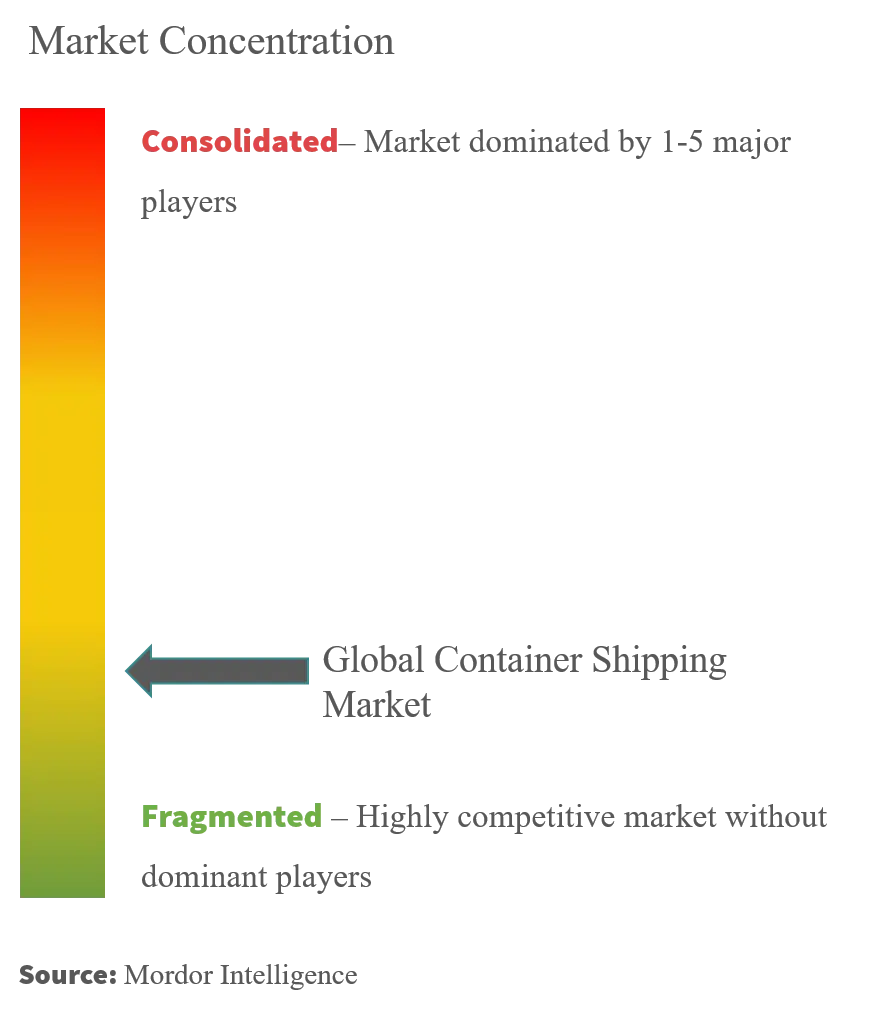
Container Shipping Market News
- January 2024: SITC signed a framework agreement with Xiamen Port Holdings Group on January 2024, aiming to boost logistics jointly. Headquartered in Hong Kong, SITC is an intra-Asia shipping logistics company. The new agreement will see the two parties focus their cooperation on route network layout, international transit, complete logistics service chain, cross-border e-commerce, hinterland cargo source expansion, port intelligence, and digital transformation.
- May 2023: Mazagon Dock Shipbuilders enters the container manufacturing business after receiving an order from the Container Corporation of India Ltd (CONCOR) for 2,500 cargo-carrying steel boxes.
- January 2023: AP Moller-Maersk (Maersk) announces the completion of its acquisition of Martin Bencher Group, a Danish Project Logistics expert with premium capabilities within non-containerized project logistics and global operations. With the addition of Martin Bencher, they are strengthening their ability to offer project logistics services to their international clients while providing a more comprehensive offering to various industries.
Container Shipping Market Report - Table of Contents
1. INTRODUCTION
- 1.1 Study Assumptions
- 1.2 Scope of the Study
2. RESEARCH METHODOLOGY
- 2.1 Analysis Methodology
- 2.2 Research Phases
3. EXECUTIVE SUMMARY
4. MARKET DYNAMICS AND INSIGHTS
- 4.1 Current Market Scenario
-
4.2 Market Dynamics
- 4.2.1 Drivers
- 4.2.1.1 Increasing volume of international trade
- 4.2.1.2 The rise of trade agreements between nations
- 4.2.2 Restraints
- 4.2.2.1 Surge in fuel costs affecting the market
- 4.2.2.2 Increasing trade tension
- 4.2.3 Opportunities
- 4.2.3.1 Technological advancements in the market
- 4.2.3.2 Expanding global trade
- 4.3 Value Chain/Supply Chain Analysis
- 4.4 Industry Policies and Regulations
- 4.5 Technological Developments in the Logistics Sector
-
4.6 Industry Attractiveness - Porter's Five Forces Analysis
- 4.6.1 Threat of New Entrants
- 4.6.2 Bargaining Power of Buyers/Consumers
- 4.6.3 Bargaining Power of Suppliers
- 4.6.4 Threat of Substitute Products
- 4.6.5 Intensity of Competitive Rivalry
- 4.7 Impact of COVID-19 on the Market
- 4.8 Insights into End Users in the Market
5. MARKET SEGMENTATION
-
5.1 By Size
- 5.1.1 Small Containers
- 5.1.2 Large Containers
- 5.1.3 High Cube Containers
-
5.2 By Type
- 5.2.1 General Container Shipping
- 5.2.2 Reefer Container Shipping
-
5.3 By Geography
- 5.3.1 North America
- 5.3.1.1 United States
- 5.3.1.2 Canada
- 5.3.1.3 Mexico
- 5.3.1.4 Rest of North America
- 5.3.2 Europe
- 5.3.2.1 Germany
- 5.3.2.2 France
- 5.3.2.3 United Kingdom
- 5.3.2.4 Italy
- 5.3.2.5 Rest of Europe
- 5.3.3 Asia-Pacific
- 5.3.3.1 China
- 5.3.3.2 Japan
- 5.3.3.3 Australia
- 5.3.3.4 India
- 5.3.3.5 Singapore
- 5.3.3.6 Malaysia
- 5.3.3.7 Indonesia
- 5.3.3.8 Thailand
- 5.3.3.9 Rest of Asia-Pacific
- 5.3.4 Middle East and Africa
- 5.3.4.1 Egypt
- 5.3.4.2 Qatar
- 5.3.4.3 Saudi Arabia
- 5.3.4.4 United Arab Emirates
- 5.3.4.5 South Africa
- 5.3.4.6 Rest of Middle East and Africa
- 5.3.5 South America
- 5.3.5.1 Brazil
- 5.3.5.2 Colombia
- 5.3.5.3 Rest of South America
6. COMPETITIVE LANDSCAPE
- 6.1 Market Concentration Overview
-
6.2 Company Profiles
- 6.2.1 AP Moller-Maersk AS
- 6.2.2 MSC Mediterranean Shipping Company SA
- 6.2.3 CMA CGM
- 6.2.4 China COSCO Holdings Company Limited
- 6.2.5 Hapag-Lloyd
- 6.2.6 ONE (Ocean Network Express)
- 6.2.7 Evergreen Line
- 6.2.8 Wan Hai Lines
- 6.2.9 Zim
- 6.2.10 SITC
- 6.2.11 Zhonggu Logistics Corp.
- 6.2.12 Antong Holdings (QASC)*
- *List Not Exhaustive
- 6.3 Other Companies
7. FUTURE OF THE MARKET
8. APPENDIX
Container Shipping Industry Overview
Container shipping refers to transportation through containers from one place to another. Unlike conventional shipping, container shipping uses containers of various standard sizes to load, transport, and unload goods or objects. As a result, containers can be moved by trains, ships, and trucks.
The report provides a comprehensive background analysis of the container shipping market, covering the current market trends, restraints, technological updates, and detailed information on various segments and the industry's competitive landscape. The impact of COVID-19 has also been incorporated and considered during the study.
The container shipping market is segmented by size (small, large, and high cube containers), type (general container shipping and reefer container shipping), and geography (North America, Europe, Asia-Pacific, Middle East and Africa, and South America). The report offers market size and forecasts value (USD) for all the above segments.
| By Size | Small Containers | ||
| Large Containers | |||
| High Cube Containers | |||
| By Type | General Container Shipping | ||
| Reefer Container Shipping | |||
| By Geography | North America | United States | |
| Canada | |||
| Mexico | |||
| Rest of North America | |||
| Europe | Germany | ||
| France | |||
| United Kingdom | |||
| Italy | |||
| Rest of Europe | |||
| Asia-Pacific | China | ||
| Japan | |||
| Australia | |||
| India | |||
| Singapore | |||
| Malaysia | |||
| Indonesia | |||
| Thailand | |||
| Rest of Asia-Pacific | |||
| Middle East and Africa | Egypt | ||
| Qatar | |||
| Saudi Arabia | |||
| United Arab Emirates | |||
| South Africa | |||
| Rest of Middle East and Africa | |||
| South America | Brazil | ||
| Colombia | |||
| Rest of South America | |||
Container Shipping Market Research FAQs
How big is the Container Shipping Market?
The Container Shipping Market size is expected to reach USD 119.65 billion in 2025 and grow at a CAGR of 3.11% to reach USD 139.45 billion by 2030.
What is the current Container Shipping Market size?
In 2025, the Container Shipping Market size is expected to reach USD 119.65 billion.
Who are the key players in Container Shipping Market?
A. P. Moller-Maersk A/S, MSC Mediterranean Shipping Company S. A., CMA CGM, China COSCO Holdings Company Limited and Hapag-Lloyd are the major companies operating in the Container Shipping Market.
Which is the fastest growing region in Container Shipping Market?
Asia Pacific is estimated to grow at the highest CAGR over the forecast period (2025-2030).
Which region has the biggest share in Container Shipping Market?
In 2025, the North America accounts for the largest market share in Container Shipping Market.
What years does this Container Shipping Market cover, and what was the market size in 2024?
In 2024, the Container Shipping Market size was estimated at USD 115.93 billion. The report covers the Container Shipping Market historical market size for years: 2020, 2021, 2022, 2023 and 2024. The report also forecasts the Container Shipping Market size for years: 2025, 2026, 2027, 2028, 2029 and 2030.
Our Best Selling Reports
Container Shipping Market Research
Mordor Intelligence delivers a comprehensive analysis of the container shipping industry. We leverage our extensive expertise in global shipping industry research and consulting. Our detailed examination covers containerized shipping operations, container shipping services, and international container shipping dynamics across major trade routes. The report provides in-depth container shipping statistics and analysis of container shipping data. This offers stakeholders valuable insights into ocean container shipping trends and container shipping business developments. Our research methodology encompasses both qualitative and quantitative analysis of global container trade patterns and shipping industry growth indicators.
Stakeholders in the container shipping market gain access to crucial insights through our downloadable report PDF. This includes detailed shipping industry forecast analysis and container shipping volume statistics. The report examines container shipping business models and operational strategies employed by leading container freight companies and international container shipping companies. Our analysis covers shipping container market dynamics, container shipping services evolution, and projected container ship growth patterns. The comprehensive coverage enables businesses to make informed decisions based on shipping industry worth assessments and container shipping industry outlook projections. These are supported by robust container shipping market analysis and global shipping industry market size data.

